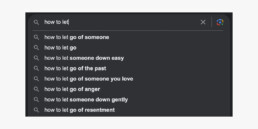A guest blog by Aini Butt.
The biggest mistake we make is when we put terms and conditions on the act of letting go; that in itself is a paradox.
I know that this will be directly in contradiction with the countless podcasts, self-help books and motivational quotes you will find. I turned to all of these at some point, and it would be a lie to say that they did not provide me momentary respite. However, as time went by, I found myself more conflicted than before. Until talking to a friend led me to recognise the paradoxical nature of controlling the act of letting go.
As we experience life’s many turns, it is inevitable that we face hurt, grief and disappointment. Often we hold on to these events for various reasons, which may manifest itself in our daily lives as: anger, pain, lack of self-worth, anxiety – the list is as endless as our lived experiences.
Nature teaches us so much about the act of letting go. At the height of its bloom, a tree will set itself ablaze to adapt to its changing environment and gracefully let go of its leaves to ensure survival during the cold winter months.
‘Tired from holding on, into my Mother’s lap I descend.
With the knowledge that I will bloom again, this is not my end.’

These were the final lines from my poem depicting the tree’s journey of letting go. Yet I failed to learn the lesson Mother Nature was trying to teach me: true growth requires letting go of one’s dead leaves and trusting one’s ability to bloom once again. Although I knew WHAT I needed to do, the HOW was still a mystery, so like many I also turned to the great Google for advice.
A search for the words ‘how to let’ is finished off with a range of suggestions with ‘how to let go of someone’ and ‘how to let go’ right there at the top. Whether it is to let go of someone or something, there are countless places to turn to advice.
Even on Spotify, searching just the word ‘letting’ results in a long list of podcasts on how to let go. I can’t deny the fact that some of these provided very good insight and powerful advice when I needed it the most.
However, the more I focused on letting go, the more my mind was reminded about things that I was trying to let go of. In those haunting moments when the daily tasks became too much, I resorted to a prioritisation technique which helped me organise myself better at work. However, this time, I wasn’t at work, so the checklist included all the little things I needed to do to function as a ‘responsible’ adult. I even added relaxing to ensure that I ticked that box off. I remember proudly telling my friend that I was managing my emotions better because I was ticking off the boxes one by one. It was at that moment that she said something that I did not understand at the time, but continuously reflected on: ‘Why do you need to write to have a shower and relax?’
The worst thing was that I had forgotten to add lunch to my list, which meant that I forgot to eat while trying to work through each task.
Although the list allowed me to have a productive day, it didn’t provide the time and space I needed to reflect on my emotions. My own writing became a reminder for me: An escape route will become a maze if you are running from yourself. Similarly, listening to podcast after podcast and making a list of active steps towards letting go allowed me to move through the initial stages, but eventually it became yet another way of running from what actually needed my attention. Maybe it was toxic productivity under the guise of self-care because it was only addressing things at the surface level.
Recognising the emotion and acknowledging its presence is the first step, just like observing a tiny ripple at the surface of deep waters. We often name one conscious emotion, but we forget that sometimes opposing emotions and thoughts can exacerbate the inner conflict. Until we acknowledge the full range of our emotions, this internal battle will not come to a ceasefire as it will result in the biggest form of self-betrayal: silencing your inner voice or gaslighting yourself.
The paradox lies in actively working towards letting go; we become consumed with the idea of not thinking about something when actually just the thought itself will make you focus more on the issue. Tell yourself not to think about elephants and the first thing your brain will do is give you an image of an elephant. This simple example shows that our minds will depict what we are familiar with. Our brains are beautifully complex, but we forget that our physical, emotional and mental health are all wired together. So, when we focus on moving on or letting go, our minds will try to provide us with images of what this may look like according to our past experiences. When we cannot fall back on our past, the only depiction of what ‘letting go’ looks like is formed through a checklist of ‘how to let go’. However, in our obsession (or desperation) to move on, we forget that two people who have experienced the same situation will not live those experiences in the exact same way, and neither will they process these according to a generalised checklist. As a result, the inner conflict rages on when you tell yourself that you have ticked off all the boxes so surely you should have been able to ‘let go’ by now. This is when we start looking at ways to blame ourselves rather than using this as an opportunity to reflect – not just reflect the ripples, but critically self-reflect on the depths of those emotions.
When it becomes too difficult (or too painful) to look beyond the surface, it is helpful to talk to someone. Whether it be a friend, a coach, a therapist or anyone else who you can open up to without any judgement. Reflecting through the lens of our past experiences and others’ expectations of how to process these can often result in distortion.
As Rumi said,
‘The one who has a good friend doesn’t need any mirror.’
A friend who will become your mirror and reflect without any filters, someone who will listen and support the dive within. I have been blessed with friends who have been my mirror to reflect not only the ripples but also remind me of the values I stand for. Although they can clear the fog and help me to see what the mirror holds, they cannot change the lens of past hurt, betrayal or anger. How often have you sought validation from the mirror with a forced smile? Mirrors do not lie yet you continue to deceive yourself to run from the journey within, which cannot be signposted through a set of generalised bullet points.
Therefore, when practising the art of letting go we need to seek opportunities for reevaluating our values through critical self-reflection, which requires the recognition of our conscious emotions and taking responsibility for our actions as these are underpinned by our values. Burns (2002) defines critical self-reflection as:
‘The process by which adults adopt alternative perspectives on previously taken for granted ideas, actions, forms of reasoning and ideologies.’
These alternative perspectives require a conscious reevaluation of our values and their origin. The roots of these values are often formed early in our childhood and continue to be a guide for all our responses to external factors. When our emotional response to painful experiences differs from those around us and continues to haunt our reflection, it becomes vital to travel to the roots of our values and find the suppressed emotions.
This is where you will find the first steps to letting go, which is all you need when embarking on a journey within – a path only you will tread upon.


